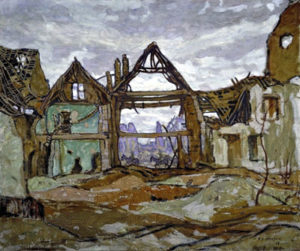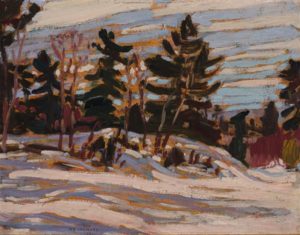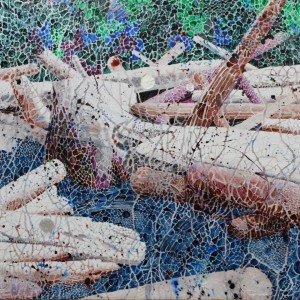Dear Artist,
Researchers at the Volen Center for Complex Systems at Brandeis University have taken a second look at “imitation learning.” It seems that when natural talent is added to one’s flagrant imitation of others, what results may be the dual assets needed to gain proficiency. Repeated practice and focused desire come into the equation as well. “We are trying to determine what strategies will optimize imitation learning,” says study co-author Robert Sekular. “These strategies are crucial for acquiring many of the skills needed in daily life. A lot of what we do is learned by watching and imitating others.” This includes tying our shoes, feeding ourselves and, apparently, creating art.

Houses of Ypres, 1917
by A.Y. Jackson (1882-1974)
“What to paint was a problem for the war artist… The old heroics, the death and glory stuff, were gone for ever; The impressionist technique I had adopted in painting was now ineffective, for visual impressions were not enough.” (A.Y. Jackson)
Humans have a natural tendency — in some cases a necessity — to do things in the “correct” way. Much basic learning is done in “monkey see, monkey do” methodology. This goes for sophisticated procedures as well. Novice heart surgeons, for example, learn order, technique and proficiency by watching seasoned pros. Golf swings are refined by playing Tiger’s videos. Complex ballet steps are mastered by observing the legs and feet of expert ballet dancers. It’s the honoured principle of the “demo.” While some human activities are more formalized than others, “visual recipe gathering” is part of our psyche.
The visual arts present a problem in this area. Time-tested processes and academic principles are, of course, valuable, but when large numbers of artists begin to imitate one another a kind of rigor mortis creeps into the creative landscape. Art often expects and demands that one artist be unique from the next. Artists on a quest to find “the secret” can easily fall into the imitation pit. In art, there’s no single, golden way. Ideally, individualists need to sidestep imitation learning and instead rely on direct observation of either the physical world or the universe of the human mind. That’s why self-education is so important in the visual arts. Becoming a student of your own processes and following your nose in the quietude of your workspace can be the most effective route to private bliss and public success.

Winter, Algoma / Wood Interior (verso), 1920
Double-sided oil on board
8.3 x 10.5 inches
by A.Y. Jackson
Many art schools understand and exemplify this dichotomy by teaching little but attitude. This is often a mistake. Those experts at Brandeis say we grab our basics by imitation learning, but it seems it is only later that we get a decent grab at attitude.
Best regards,
Robert
PS: “All education must be, in the end, self-education.” (Robert Henri)
Esoterica: If you accept the proposition, as many do, that imitation learning is the swiftest way to proficiency in the arts, a certain obligation comes with your process. Sooner or later you must give a personal spin and attempt to raise your standards beyond that of your imitated master. Apart from being valuable in the building of self-esteem, this move is vital to wider acceptance and is more in harmony with the idealized wisdom of art history. There is a price to pay if you don’t. In the words of landscape painter A. Y. Jackson, “Those who follow are always behind.”
This letter was originally published as “Imitation learning” on April 24, 2007.
Have you considered a Premium Artist Listing? With each letter, an artist is featured at the bottom of this page. The Premium Artist Listings are a means of connecting artist subscribers through their work. Proceeds from each listing contribute to the production of The Painter’s Keys.
“We must not imitate that which we seek to create.” (Georges Braque)
Featured Artist
We live in a fractured world. Wars, famine and power games are forcing people to abandon their homes and their way of life in hopes of finding peace. For lack of education or specialized skills, the poor are not accepted into our northern communities. They stay in the camps on the borders of turmoil, separated from local community. Animals are caught in the crossfire. Even the trees and the rocks suffer the agony of imbalance. This chaos is evident in my work. In between the rivulets of paint and the textural accidents I choose colours and forms to suggest a landscape where beauty continues to reign. We can still change the tide and build a new world harmony. Certainly, contemporary will focuses on gold instead of beauty. Yet, beauty is essential to the wellbeing of the planet. She is essential to the survival of humanity.






16 Comments
Thank you!!! Such wise words, I love hearing/reading them!!
The Group of Seven is a very unique part of art history that I would have preferred to know about earlier. Crazy guys carrying their paints all over the wilds of Canada. It seems like plein are with more design. Great to look at, all of them.
We can try to follow their approach to painting, but not stand in their shoes.
Thanks.
They were not all guys. I believe there was one woman in the group of seven…Emily Carr.
Nope. Accepted by them but not one of the seven. Carr was an amazing artist and wonderful writer as well. A true eccentric she painted in the wilds of BC into her old age.
My studio education in drawing and painting was post-college and after retirement. I didn’t feel pressured or even influenced to paint like the instructors. But I do remember so admiring another student that I wanted to paint just like her! I tried this, and it didn’t work, of course. That’s when I realized that I have to paint my own way, whatever that was.
I’m still trying to figure out what my style is. When I look at the variety of my creations, I don’t se e a unifying style. Lately I just go ahead and do it, without worrying about style. Much more fun.
Ditto…I think it may be that we (us elders) are not attempting to become famous. We do it cause it feels so damn good…quoting David Byrnes
I like your reply. We ( us elders ) should be doing art for the pleasure it brings. I should try to live by those words.
I taught for a month in Japan a few years ago. My students were definitely imitators. I started a 2-day watercolor session with some color theory, drew an abstract doodle and painted it in with complements. They copied my doodle and my color choices precisely. By the second day they were painting well, with their own ideas, though not as adventurous as Americans. I thought they were somewhat robotic. Then I went to a gallery in Tokyo and saw their calligraphic WORK. I was stunned and amazed at the inventiveness. It is only through this disciplined beginning which is part of their culture that they got these results. When I taught some Americans a few months later, they went their own way without comprehending these fundamentals, and the work by the end of the workshop did not communicate on the same level.
I compare it to classical training in drawing, which gives us the skills to execute complex ideas, a photographer knowing how his camera works to get the best shots. It’s like a good writers understanding of grammar, a good musician’s precision on finding the notes at the right time. Good art has great content, a great story to tell, a great interpretation of a tune. Housed in great skill makes it even better. But it all comes down to having something to say.
Love these A. Y. Jackson paintings. Love your articles.
❣️
I definitely feel “Imitation Learning” is very important (I have learned alot from watching painters use their brush). When it comes to creating I believe it is actually self education as Robert Henry describes. It seems like a journey without a map but then you discover along the way that you can add a new path within the wilderness of making art….which becomes your prefered path. Some paths are more travelled, others less.
It seems, however, that the narrow path that one may trek may soon be overgrown if one does not continue along it often enough. Once the path is well established, through miles of canvas, it may invite others to walk along that path and bring us something to imitate. Enjoy your journey!
Thank you for these <3 words, I have been struggling with "creative or impulsive art" I like to found someting I can copied (photos, paintings) and than research thecniques & materrials to develop my skill. I give most of my paintings away because I do not feel right to sell something i did not entirely created. So yes, it is a Personal development & Education (Y)
One of my projects when I was teaching design was to have students copy, to the best of their ability, a painting they liked as step 1. They were to analyze it as they went: what color/scheme, types of shapes, arrangement, and so on. Written notes and the experience were then used to interpret the work into their own version. Usually in a different medium like collage or bas relief.
I have always found it very interesting that writers admit to being big readers interested in other writers and very happy to name writers they admire and study and are quite open about the influence that other writers have on them. Visual artists, especially painters seem to be less willing to talk about other artists as having a distinct influence on them. It seems as if their “originality is somehow suspect if they admit that they have learned by looking at and studying other painters.
This is such a great letter that never loses it’s worth no matter what stage and age we are at with painting. I remember wanting to soak up all the talent of others who I admired in my beginning, felt if watched close enough, some of their success would rub off on me. I remember the cliques in groups who taught and led, then shunned the ones they taught for copying them. Life in art is a complicated field to play in. Human nature to want to be accepted, admired and reach that bar those we look up to set. I remember so many getting addicted to workshops out of fear of going to their room and bloody well finding their own voice. I shouldn’t look back, it makes me cranky. :)… but really, why are we so afraid of ourselves? Lots of reasons I suppose. Fear of rejection, fear of failure, fear of not fitting in, fear of wasting time and paint. I’ve experienced all of those things big time, and here I am still at it thinking I’m not so bad afterall. Thank you, Robert! and Sara :)
Occasionally I come across work that I really love and wish I had made, by an artist new to me. I’ve learned the best thing to do to cope with the envy is to try to paint in their style. This is such an education as I soon find my own style breaking through and this helps me to see how my work differs and its strengths and also to get clearer about where their visual language overlaps with mine. I can then move on peacefully, having learned respect both for them and for what comes naturally to me.
Great quotes in this letter!